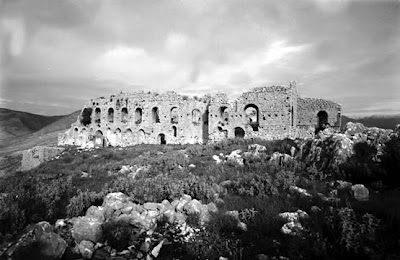
Saranda or Sarandë is the capital of the District of Sarandë, Albania, and is one of the most important tourist attractions of the Albanian Riviera. It is situated on an open sea gulf of the Ionian Sea in the Mediterranean 2 nautical miles from the Greek island of Corfu. The city of Saranda has a population of about 30,000 (2001 estimate). Alongside its ethnic Albanian majority, Sarandë is home to an ethnic Greek minority and is considered one of the centers of the Greek minority in Albania.
Sarandë's current name derives from the name of the Byzantine Monastery of the Agioi Saranda (Greek: Άγιοι Σαράντα), meaning the "Forty Saints" and honoring the Forty Martyrs of Sebastea. Under Turkish rule, this became Aya Sarandi and then Sarandoz. Owing to Venetian influence in the region, it often appeared under its Italian name Santi Quaranta on western maps. This usage continued even after the establishment of the Principality of Albania, owing to the first Italian occupation of the region. During the second occupation in World War II, Benito Mussolini changed the name to Porto Edda, in honor of his eldest daughter. Following the restoration of Albanian independence, the city employed its Albanian name Saranda.
Source

The Church of the Forty Martyrs
On the hill above Saranda, affording a magnificent panorama, is located the extraordinary Church of the Forty Martyrs. The hill has views down over the bay of Saranda and along the Ksamili peninsula to Butrint, and there are equally breathtaking views inland to Phoenicê and the mountains range beyond.
The church was built in late antiquity, in the late 5th or early 6th century, probably by a Holy Man, and designed to be an important place of pilgrimage. The site was first investigated in the 1920s by the Italian Archaeological Mission; sadly, it was bombed by Allied or German forces during the Second World War, and probably dynamited for use as an Albanian military area in the late 1950s, hence only a fraction of the monument now remains.
The Church of the Forty Martyrs was a large 40-metre long church with an extraordinary ground plan: a large eastern apse and three wide apsidal bays opening off the nave on each side. Great round-headed windows, five to each bay, lit the interior. This was a sophisticated building, roofed with a series of domes and semi-domes. On the north and west-facing exterior walls of the basilica still survives the votive inscriptions fashioned of red tiles set into the masonry, recording the names of founding benefactors – both male and female – who contributed to the cost of the construction.
In a later phase an outer narthex was added, designed to be prominent to seafarers passing through the Ionian Sea north of Corfu and, specifically, to those in Saranda below. Further, the interior walls were redecorated throughout. In particular, within the multi-chambered subterranean chapels of the crypt recent conservation has revealed elaborate painted programmes, including an episode in which Christ pulls at the beard of a nimbed saint. This second phase of decoration probably belongs to the later 9th or 10th centuries.

The main relic chambers, reached by narrow passages, lay on the south side at the end of a long vaulted hall. Traces of a line of saints and a painted cross were discovered around the two fenestellae beyond which the relics were located. A modest bath-house to the north was probably where pilgrims would have bathed before visiting the relics.
The unusual plan of the basilica is paralleled in late antique multi-apsed triclinia, such as the banqueting hall of the Palace of Lausos in Constantinople, and some related features are found in early Christian martyria. However, as a church this building is unique, designed to enshrine and promote the relics of widely venerated saints. In the age of Justinian in the 6th century it must have been one of the most visually striking pilgrimage basilicas in the central Mediterranean.
Entry to the church can only be gained by contacting the Institute of Monuments either in Saranda or Tirana.
Source